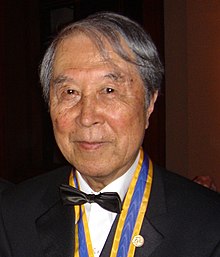Yoichiro Nambu
Yoichiro Nambu (南部 陽一郎, Nanbu Yōichirō, 18 January 1921 – 5 July 2015) was a Japanese-born American physicist, a professor at the University of Chicago.[1]
Yoichiro Nambu 南部 陽一郎 | |
|---|---|
 | |
| Born | 18 January 1921 |
| Died | 5 July 2015 (aged 94) Osaka, Japan |
| Nationality | Japan |
| Citizenship | Japan; United States (1970-death) |
| Alma mater | Tokyo Imperial University |
| Known for | Spontaneous symmetry breaking |
| Awards | Heineman Prize (1970) US National Medal of Science (1982) Dirac Medal (1986) J.J. Sakurai Prize (1994) Wolf Prize in Physics (1994/1995) Pomeranchuk Prize (2007) Nobel Prize in Physics (2008) |
| Scientific career | |
| Fields | Physics |
| Institutions | University of Tokyo (1942–49) Osaka City University (1949–52) Institute for Advanced Study (1952–54) University of Chicago (1954–) |
Works
changeNambu was known for his works to the field of theoretical physics, he was awarded a one-half share of the Nobel Prize in Physics in 2008 for the discovery in 1960 of the mechanism of spontaneous broken symmetry in subatomic physics, related at first to the strong interaction's chiral symmetry and later to the electroweak interaction and Higgs mechanism.[2]
The other half share was split equally between Makoto Kobayashi and Toshihide Maskawa "for the discovery of the origin of the broken symmetry which predicts the existence of at least three families of quarks in nature."[3]
Nambu became a U.S. citizen in 1970.
References
change- ↑ "2008年ノーベル物理学賞受賞の南部陽一郎 大阪大学特別栄誉教授がご逝去されました". Osaka University. 17 July 2015. Retrieved 17 July 2015.
- ↑ Nambu, Yoichiro (2008). Karl Grandin (ed.). Les Prix Nobel. The Nobel Prizes 2008. Stockholm: The Nobel Foundation. Archived from the original on 11 October 2014. Retrieved 22 May 2012.
- ↑ (according to the NP citation).